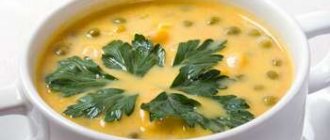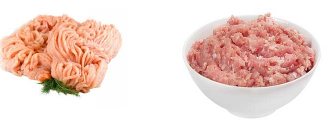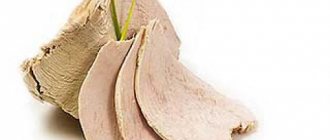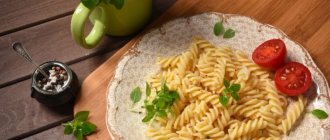Recipe
- Slice the breast meat across the grain to form good chops.
- Chicken fillet is quite tender and soft, so it is important not to “overwhelm” it. It’s worth fighting him off without unnecessary fanaticism. It is convenient to beat it by covering it with cling film on top.
- If desired, you can improve the taste of future chops. An apple will be useful for this. It needs to be grated on a medium-sized grater, and the juice squeezed out of the resulting mixture. You need to dip each chop in the juice. After that, let them stand for about thirty minutes.
- After this, sprinkle each piece with a mixture of salt and pepper and brush with mayonnaise.
- These chops need to be thoroughly cooled. They just need to be refrigerated for a few hours.
- Beat eggs with salt and pepper.
- Place flour on a flat plate. You can make a batter, but it can be simpler - successively dip each chop in flour, and then in a beaten egg.
- Preheat a frying pan with vegetable oil.
- Fry the chops over high heat until they begin to brown. Then reduce the heat, cover the pan with a lid, and bring to readiness for five to seven minutes.
- In order for the finished chops to get rid of excess fat, they need to be laid out on a napkin or paper towel.
This dish is very simple and quick to prepare; it is not a shame to treat unexpected guests or place it on a festive table.
Using our step-by-step recipe with photos, you can easily prepare delicious and juicy chicken fillet chops in batter, fried in a frying pan until golden brown. Among the many options, we offer you a simple recipe that requires the most common ingredients. Even the most novice cook can prepare delicious chicken fillet chops. Chicken meat is ideal for such a dish: it cooks quickly, is quite dietary and turns out quite tender and juicy.
Chicken chops can be cooked in batter or breaded, in the oven or in a frying pan. In our photo recipe we will describe in detail a simple method of preparing tender chicken chops in batter fried in a frying pan.
Recipes
Chicken fillet in egg in a frying pan
We will need:
- chicken breast 1 pc.;
- egg 2 pcs.;
- flour 2 tbsp. l.;
- frying oil;
- salt and pepper to taste.
Preparation.
- We turn the washed chicken breast into fillet, clearing it of skin, bones and films. Cut into portions no more than a centimeter thick.
- We beat each piece through the film.
- Rub the chops with salt and pepper, you can add your favorite seasonings and leave in the marinade for half an hour.
- In a separate plate, combine the eggs and salt, beat everything, then add flour to the mixture and mix.
- Dip the chops in the egg batter and fry in a frying pan with butter for 5 minutes on each side.
Fillet with omelette and cheese
Ingredients:
- chicken fillet 400 g;
- egg 4 pcs.;
- mayonnaise 1 tbsp. l.;
- onion 1 pc.;
- olive oil 1 tbsp. l.;
- hard cheese 100 g;
- salt and pepper to taste;
- greenery.
Step by step recipe.
- Chop the fillet into portions, place in a baking dish, greased with oil, salt and pepper.
- Chop the onion into half rings or rings and place in the next layer.
- Chop the greens and sprinkle on top.
- In a separate bowl, combine the eggs with mayonnaise, add a little salt, and mix with a whisk.
- Pour the resulting mixture over the previously prepared fillet. Place in the oven for 40 minutes at 180 degrees.
- We take out the finished dish, sprinkle with grated cheese and send it back - the cheese will melt in a few minutes in a hot oven.
How to cook delicious chicken chops
To prepare delicious and juicy chicken chops you need to know a few culinary secrets. The first thing you need to do is cut the chicken fillet correctly, then beat it with a special hammer and, of course, prepare the batter and fry it in a frying pan. We'll talk about all these processes below, but now we'll give you a few little tricks that will help you make perfect chops.
— When choosing meat for chops, opt for chilled products. Chicken breast fillets are ideal, but chicken is best.
- Carefully monitor the moisture content of the fillet. If you have washed the meat beforehand, be sure to dry it on paper towels. The beaten chicken fillet placed in the frying pan must contain a minimum amount of moisture, otherwise the crust on the meat will take longer to form and the chicken will lose more juice. As a result, the chop will not be as juicy.
— The meat should be cut into pieces along the grain and 1.5 cm thick.
— It’s good to beat chicken fillet, but know when to stop, the meat should not be visible.
— Fry chops in batter or breading and place them exclusively in a well-heated frying pan with a small amount of oil.
- Chicken fillet - 0.5 kg.
- Flour - 100 gr.
- Chicken eggs - 2 pcs.
- Vegetable oil
- Ground pepper
- Seasoning for chicken
To ensure juicy chops, use fresh meat, not defrosted. The chicken fillet must be thoroughly washed and dried with a paper towel or napkin.
Cut the fillet into equal pieces no more than two centimeters thick.
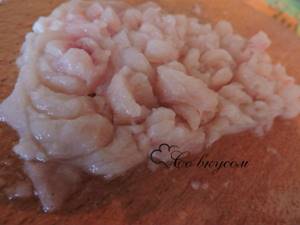
Pound the meat with the blunt side of a mallet. Remember that the chicken should not be beaten too hard so as not to disturb its structure.
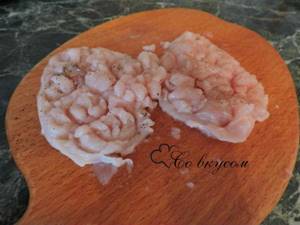
Pepper the meat and add spices to taste. The chops should be salted after the meat has crusted over during frying.

To prepare the batter for chicken chops, beat two eggs in a separate bowl.
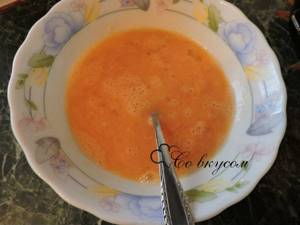
Place a small amount of flour on the counter or cutting board.
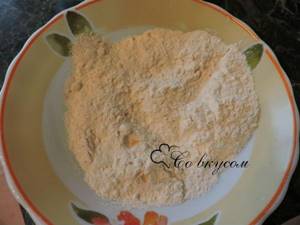
Dip the meat first in flour and then dip it in the egg. This egg batter will also help make the chops juicy.

All the preparatory work has been done, now all that remains is to fry.
Fry chicken chops in a heated frying pan moistened with olive or sunflower oil.
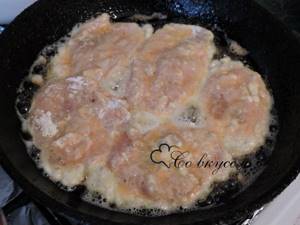
Fry the dish over medium heat for two minutes on each side. Once one side is golden, flip the chop over to the other.
Fried chicken chop, 1 pc. (TTK0134)
Technical and technological map No.
Fried chicken chop, 1 pc. (CP-recipe No. 717
)
Publishing house "Economy", Moscow 1983
- APPLICATION AREA
This technical and technological map applies to leg of lamb baked in wine glaze,
generated into the name of the object, city.
- REQUIREMENTS FOR RAW MATERIALS
Food raw materials, food products and semi-finished products used for the preparation of fried chicken chop,
must comply with the requirements of current regulatory and technical documents, have accompanying documents confirming their safety and quality (certificate of conformity, declaration of conformity, quality certificate, etc.).
The preparation of raw materials is carried out in accordance with the recommendations of the Collection of technological standards for public catering establishments and technological recommendations for imported raw materials.
- RECIPE
| Name | Raw material consumption per serving, g | ||||
| Gross weight, g | % when cold processed | Net weight, g | % during heat treatment | Output, g | |
| Frozen chicken chop, semi-prepared | 120,0 | 1.00 (stack during defrost) | 118,8 | 12,50 | 104,0 |
| Salt | 1,0 | 0,00 | 1,0 | 100,00 | 0,0 |
| Ground black pepper | 0,1 | 0,00 | 0,1 | 100,00 | 0,0 |
| Seasoning for chicken | 0,2 | 0,00 | 0,2 | 100,00 | 0,0 |
| Wheat flour | 10,0 | 10.00 (loss during breading) | 9,0 | 10,00 | 8,0 |
| Chicken eggs | 0.2 pcs. | 6.00 (loss during breading) | 9,4 | 12,00 | 8,3 |
| Vegetable oil | 20,0 | 0,00 | 20,0 | 51,50 | 9,7 |
| Exit | 1 PC. x 130 g | ||||
- Cooking technology Fried chicken chop, 1 pc.
The chicken chop is defrosted at room temperature, seasoned with salt, ground black pepper, chicken seasoning, and breaded in flour.
Beat chicken eggs until foamy. Dip the breaded chop into the egg and fry in a frying pan heated with vegetable oil on both sides until golden brown. Bring to readiness in the oven at t +170+180* C for 8-10 minutes.
Place the finished chicken chops in a serving bowl.
If the products are planned to be transported to another facility, they are cooled in a shock freezer at a temperature of -43-38* C to a temperature of +3* C, placed in a shipping container, and labeled (product name, weight, date and time of manufacture).
Transported in a refrigerated car body.
- Characteristics of the finished dish, semi-finished product Fried chicken chop, 1 pc.
Appearance
– oval-shaped chicken chop, breaded in egg, fried until golden brown.
Taste
– typical for fried chicken, fried eggs. No foreign taste.
Smell
– typical for fried chicken, fried eggs. No foreign smell.
- Requirements for design, sale and storage Fried chicken chop, 1 pc.
Chicken chop
fry as needed.
The permissible shelf life of a chicken chop
, according to SanPiN 2.3.2.1324-03 at a temperature from 0º C to 6º C, is no more than 48 hours from the end of the technological process.
Microbiological parameters of fried chicken chop,
must comply with the requirements
of SanPiN 2.3.2.1078-01.
What side dish to prepare for chicken chops
Chicken fillet chops can be served as a separate dish or with a side dish. Mashed potatoes, pasta, rice or grilled vegetables go well as a side dish. Hot or sweet and sour sauce is also great.
From chicken fillet, in addition to classic chops, you can prepare more interesting chopped chops. To do this, chop the chicken meat with a knife, add egg, flour and spices. The taste is even more delicate than in the classic version.
— Chicken fillet — 400 gr. — Chicken egg — 2 pcs. — Flour — 100 gr. — Mustard — 1 tbsp. spoon - Sour cream - 3 tbsp. spoons – Vegetable oil – Spices – Salt
1. Cut the chicken fillet into strips or small cubes, place in a deep plate, add salt and season with spices.
2. Add eggs and mix well with chopped fillet. Then add mustard and sour cream, stirring gently. Gradually add flour and continue stirring.
3. When the mass acquires a homogeneous consistency, heat the oil in a frying pan and, using a tablespoon, add some kind of chopped chicken chops.
4. Fry each side for 2 minutes.
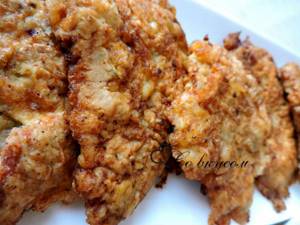
Chicken chops can not only be fried, but also baked in the oven. Chicken chops with mushrooms prepared in this way are also called French chops or under a fur coat. Mushrooms give the dish a richer flavor; you can use any fresh mushrooms, including champignons.
— Chicken fillet — 500 gr. — Champignons — 200 gr. — Cheese — 100 gr. — Tomato — 2 pcs. — Onion — 1 pc. — Mayonnaise — 3 tbsp. l. — Salt — Seasoning — Sunflower oil
1. Cut the chicken fillet into pieces, cover with cling film and beat with a hammer. It is worth beating to a thickness of 1 cm, this will be enough.
2. Add spices and salt to each broken piece. Spread mayonnaise evenly on top and leave in a cool place for 30 minutes.
3. Peel the onion and wash the champignons. Cut the ingredients into small cubes and fry in sunflower oil.
4. Cover a baking sheet with foil, lightly grease with oil and place the chops. Spoon the fried mushrooms and onions on top.
5. Wash the tomatoes, cut into thin half rings and place on top of the mushrooms.
6. Sprinkle grated hard cheese on top, thereby forming a kind of fur coat.
7. Place the resulting beauty in the oven for 25 minutes. Chicken chops with mushrooms should be baked in French at a temperature of 200 degrees.
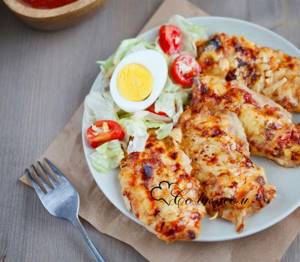
To prepare chicken chops with pineapple, cut the chicken fillet into pieces and pound under cling film to a thickness of 1 cm. Add spices and lightly fry in vegetable oil. You shouldn’t fry for too long, just 1 minute on each side is enough.
Then place the chops on a foil-lined baking sheet, brush with mayonnaise and top with chopped pineapple cubes.
Place grated cheese on top, place the baking sheet in an oven preheated to 180 degrees and bake for 20 minutes.
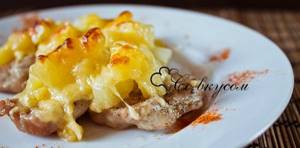
Among the variety of different chicken dishes, there is one most popular and favorite - chicken chop. The calorie content of chicken dishes is quite low, which is why they are very often the protein basis of many diets. This article will be useful for those who have decided to take up proper nutrition by calculating the calorie content of their diet. Today we will talk about the calorie content of chicken chop, cooked both in batter and steamed, and also share the most popular and delicious recipe for this dish.
Chicken chop in batter
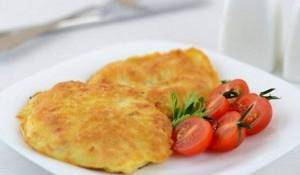
To prepare this dish for one person you will need:
- 100 grams of chicken fillet;
- 15 grams of wheat flour;
- 1 egg;
- 10 grams of sunflower oil;
- salt and black pepper to taste.
Cut the chicken fillet into small pieces, which are then thoroughly beaten with a hammer. Salt and pepper each piece and place the meat in the refrigerator for half an hour. At this time, prepare the batter. To do this, beat the egg with a whisk and gradually add flour. It is important to obtain a homogeneous mass, since during frying lumps of unmixed flour may not be fried. The next step in preparing the chop is frying. Pour sunflower oil into a hot frying pan. Dip each chop in the batter and place in the pan. Fry on each side until a nice golden color appears. The calorie content of this fried chicken cutlet in batter according to this recipe is 189.7 kilocalories. Quite low calorie content, especially for a tasty diet food. If you are still concerned about the calorie content of a chicken chop, then serve it with fresh vegetables. This way the dish will become even healthier and be better absorbed by the body.
Turkey fillet in batter - recipe and calorie content
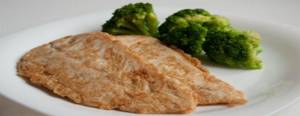
Good day, regular readers and friends of the “Lose Weight Diet” blog!
Today we will cook turkey in batter - a dietary dish of European cuisine, ideal for women losing weight. The low calorie content of turkey fillet allows it to be consumed by people who care about their figure, but do not want to exclude meat from their diet.
Turkey in batter: recipe
You should know that turkey meat is valued not only for its delicate taste, but also for its low cholesterol content. The calorie content of turkey fillet is less than 85 kcal - negligible compared to, for example, pork or lamb.
Turkey in batter, the recipe for which we publish, is prepared from the following ingredients:
- Turkey fillet - 0.6 kg
- Egg - 3 pcs.
- Milk - 2 tbsp.
- Flour - 2 tbsp.
Turkey in batter: step-by-step recipe
1) Prepare ingredients for turkey in batter:
- Cut the fillet into thin layers.
- Beat the eggs with a whisk.
2) Gently beat each strip of meat.

Cut the fillet into layers and beat
3) Then you need to salt and pepper the fillet (optional) and dip the turkey into the batter according to the recipe:
- First, roll the meat in flour.
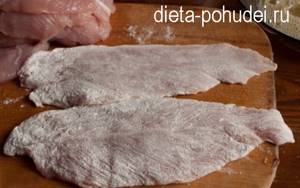
Dredge fillet in flour
- Then place the fillet in a bowl with beaten eggs.
- Dip the meat into flour again and then into the eggs.
4) Turkey in batter, the recipe for which will seem complicated only to housewives who have never cooked chops, is fried in hot vegetable oil for 3-5 minutes (on each side).

Fry the meat in vegetable oil
5) Then transfer the fried strips of meat into a heated frying pan, pour milk over them and simmer over low heat, stirring. The turkey in batter should be stewed until the milk has completely evaporated.
6) If you are following a low-calorie diet, turkey meat is best served with vegetables, for example, boiled broccoli. Since 100 g of broccoli contains no more than 30 kcal, combining meat with this healthy cabbage you can in some way “reduce” the already low calorie content of turkey fillet in batter.
Tips for cooking turkey in batter recipe:
- If you are allergic to lactose or simply have an acute lack of free time, turkey in batter can be served immediately after frying - without subsequent stewing in milk.
- The meat for preparing turkey in batter according to the recipe can be pre-marinated, for example, in soy sauce or in your favorite spices mixed with vegetable oil.
Turkey fillet calories
- Turkey fillet (0.6 kg) – 504 kcal
- Egg (3 pcs.) – 221.37 kcal
- Milk (40 ml) – 25.6 kcal
- Flour (50 g) - 171 kcal.
Calorie content of turkey fillet (100 g serving): 111 kcal.
Chicken breast chops recipe. Calorie, chemical composition and nutritional value.
chicken breast chops
rich in vitamins and minerals such as:
vitamin E – 23.7%, vitamin PP – 50.4%, potassium – 11.6%, magnesium – 18.6%, phosphorus – 16.3%, cobalt – 92.2%, molybdenum – 17.2% , chromium – 45.1%, zinc – 11.4%
- Vitamin E
has antioxidant properties, is necessary for the functioning of the gonads and heart muscle, and is a universal stabilizer of cell membranes. With vitamin E deficiency, hemolysis of erythrocytes and neurological disorders are observed. - Vitamin PP
is involved in redox reactions of energy metabolism. Insufficient vitamin intake is accompanied by disruption of the normal condition of the skin, gastrointestinal tract and nervous system. - Potassium
is the main intracellular ion that takes part in the regulation of water, acid and electrolyte balance, and is involved in the processes of conducting nerve impulses and regulating blood pressure. - Magnesium
is involved in energy metabolism, the synthesis of proteins, nucleic acids, has a stabilizing effect on membranes, and is necessary to maintain the homeostasis of calcium, potassium and sodium. A lack of magnesium leads to hypomagnesemia, an increased risk of developing hypertension and heart disease. - Phosphorus
takes part in many physiological processes, including energy metabolism, regulates acid-base balance, is part of phospholipids, nucleotides and nucleic acids, and is necessary for the mineralization of bones and teeth. Deficiency leads to anorexia, anemia, and rickets. - Cobalt
is part of vitamin B12. Activates enzymes of fatty acid metabolism and folic acid metabolism. - Molybdenum
is a cofactor for many enzymes that ensure the metabolism of sulfur-containing amino acids, purines and pyrimidines. - Chromium
is involved in the regulation of blood glucose levels, enhancing the effect of insulin. Deficiency leads to decreased glucose tolerance. - Zinc
is part of more than 300 enzymes and is involved in the processes of synthesis and breakdown of carbohydrates, proteins, fats, nucleic acids and in the regulation of the expression of a number of genes. Insufficient consumption leads to anemia, secondary immunodeficiency, liver cirrhosis, sexual dysfunction, and the presence of fetal malformations. Research in recent years has revealed the ability of high doses of zinc to disrupt the absorption of copper and thereby contribute to the development of anemia.
You can see a complete guide to the healthiest foods in the “My Healthy Diet” app.
Calorie content Chicken breast fillet chops. Chemical composition and nutritional value.
Nutritional value and chemical composition of “Chicken breast fillet chops”.
The table shows the nutritional content (calories, proteins, fats, carbohydrates, vitamins and minerals) per 100 grams of edible portion.
The energy value of chicken breast fillet chops is 268.68 kcal.
** This table shows the average levels of vitamins and minerals for an adult. If you want to know the norms taking into account your gender, age and other factors, then use the “My Healthy Diet” application.
Primary Source: Created in the application by the user.
Benefits and harms
The benefits of chicken fillet are legendary. This is a low-calorie product that is often included in the menu of athletes and those who want to get rid of extra pounds. Chicken breast contains vitamins and minerals that stabilize the cardiovascular system, have a beneficial effect on the condition of the skin, hair and nails, strengthen the immune system, and are responsible for the health of the kidneys and liver.
The main harm of chicken meat is contained in the skin, but by using fillet this problem can be avoided. Therefore, all recipes made from chicken breast and eggs are harmless, however, you should not abuse such dishes either.
A high protein content can negatively affect the digestive organs and kidneys. Also, chicken and egg dishes are contraindicated for people with relevant food allergies.
Recipe: Chicken breast chops. Calorie, chemical composition and nutritional value.
Chicken breast chops
rich in vitamins and minerals such as:
vitamin E – 43%, vitamin PP – 35%, magnesium – 18.8%, phosphorus – 21.7%, chlorine – 128.7%, iron – 11.7%, cobalt – 85.6%, manganese – 19 %, copper – 13.1%, molybdenum – 19.7%, chromium – 42.2%, zinc – 12%
- Vitamin E
has antioxidant properties, is necessary for the functioning of the gonads and heart muscle, and is a universal stabilizer of cell membranes. With vitamin E deficiency, hemolysis of erythrocytes and neurological disorders are observed. - Vitamin PP
is involved in redox reactions of energy metabolism. Insufficient vitamin intake is accompanied by disruption of the normal condition of the skin, gastrointestinal tract and nervous system. - Magnesium
is involved in energy metabolism, the synthesis of proteins, nucleic acids, has a stabilizing effect on membranes, and is necessary to maintain the homeostasis of calcium, potassium and sodium. A lack of magnesium leads to hypomagnesemia, an increased risk of developing hypertension and heart disease. - Phosphorus
takes part in many physiological processes, including energy metabolism, regulates acid-base balance, is part of phospholipids, nucleotides and nucleic acids, and is necessary for the mineralization of bones and teeth. Deficiency leads to anorexia, anemia, and rickets. - Chlorine
is necessary for the formation and secretion of hydrochloric acid in the body. - Iron
is part of proteins with various functions, including enzymes. Participates in the transport of electrons and oxygen, ensures the occurrence of redox reactions and activation of peroxidation. Insufficient consumption leads to hypochromic anemia, myoglobin deficiency atony of skeletal muscles, increased fatigue, myocardiopathy, and atrophic gastritis. - Cobalt
is part of vitamin B12. Activates enzymes of fatty acid metabolism and folic acid metabolism. - Manganese
is involved in the formation of bone and connective tissue, and is part of enzymes involved in the metabolism of amino acids, carbohydrates, and catecholamines; necessary for the synthesis of cholesterol and nucleotides. Insufficient consumption is accompanied by slower growth, disturbances in the reproductive system, increased fragility of bone tissue, and disturbances in carbohydrate and lipid metabolism. - Copper
is part of enzymes that have redox activity and are involved in the metabolism of iron, stimulates the absorption of proteins and carbohydrates. Participates in the processes of providing oxygen to the tissues of the human body. Deficiency is manifested by disturbances in the formation of the cardiovascular system and skeleton, and the development of connective tissue dysplasia. - Molybdenum
is a cofactor for many enzymes that ensure the metabolism of sulfur-containing amino acids, purines and pyrimidines. - Chromium
is involved in the regulation of blood glucose levels, enhancing the effect of insulin. Deficiency leads to decreased glucose tolerance. - Zinc
is part of more than 300 enzymes and is involved in the processes of synthesis and breakdown of carbohydrates, proteins, fats, nucleic acids and in the regulation of the expression of a number of genes. Insufficient consumption leads to anemia, secondary immunodeficiency, liver cirrhosis, sexual dysfunction, and the presence of fetal malformations. Research in recent years has revealed the ability of high doses of zinc to disrupt the absorption of copper and thereby contribute to the development of anemia.
Chicken breast chop recipe. Calorie, chemical composition and nutritional value.
Chicken breast chop
rich in vitamins and minerals such as:
vitamin A – 14.4%, vitamin E – 12.1%, vitamin PP – 73.3%, potassium – 13.7%, magnesium – 25.1%, phosphorus – 29.1%, cobalt – 133.1 %, copper – 11.7%, molybdenum – 22%, chromium – 67.1%, zinc – 15.6%
- Vitamin A
is responsible for normal development, reproductive function, skin and eye health, and maintaining immunity. - Vitamin E
has antioxidant properties, is necessary for the functioning of the gonads and heart muscle, and is a universal stabilizer of cell membranes. With vitamin E deficiency, hemolysis of erythrocytes and neurological disorders are observed. - Vitamin PP
is involved in redox reactions of energy metabolism. Insufficient vitamin intake is accompanied by disruption of the normal condition of the skin, gastrointestinal tract and nervous system. - Potassium
is the main intracellular ion that takes part in the regulation of water, acid and electrolyte balance, and is involved in the processes of conducting nerve impulses and regulating blood pressure. - Magnesium
is involved in energy metabolism, the synthesis of proteins, nucleic acids, has a stabilizing effect on membranes, and is necessary to maintain the homeostasis of calcium, potassium and sodium. A lack of magnesium leads to hypomagnesemia, an increased risk of developing hypertension and heart disease. - Phosphorus
takes part in many physiological processes, including energy metabolism, regulates acid-base balance, is part of phospholipids, nucleotides and nucleic acids, and is necessary for the mineralization of bones and teeth. Deficiency leads to anorexia, anemia, and rickets. - Cobalt
is part of vitamin B12. Activates enzymes of fatty acid metabolism and folic acid metabolism. - Copper
is part of enzymes that have redox activity and are involved in the metabolism of iron, stimulates the absorption of proteins and carbohydrates. Participates in the processes of providing oxygen to the tissues of the human body. Deficiency is manifested by disturbances in the formation of the cardiovascular system and skeleton, and the development of connective tissue dysplasia. - Molybdenum
is a cofactor for many enzymes that ensure the metabolism of sulfur-containing amino acids, purines and pyrimidines. - Chromium
is involved in the regulation of blood glucose levels, enhancing the effect of insulin. Deficiency leads to decreased glucose tolerance. - Zinc
is part of more than 300 enzymes and is involved in the processes of synthesis and breakdown of carbohydrates, proteins, fats, nucleic acids and in the regulation of the expression of a number of genes. Insufficient consumption leads to anemia, secondary immunodeficiency, liver cirrhosis, sexual dysfunction, and the presence of fetal malformations. Research in recent years has revealed the ability of high doses of zinc to disrupt the absorption of copper and thereby contribute to the development of anemia.
You can see a complete guide to the healthiest foods in the “My Healthy Diet” app.

